|
|
|
Scorecard
| Tee |
Total Yardage |
Men's Rating |
Men's Slope |
Women's Rating |
Women's Slope |
| Black |
6981 |
74.2 |
141 |
~ |
~ |
| Tan |
6515 |
72.2 |
135 |
78.7 |
145 |
| Blue |
6075 |
70.0 |
132 |
76.2 |
141 |
| Yellow |
5865 |
69.1 |
130 |
75.1 |
138 |
| Green |
5187 |
65.9 |
123 |
71.2 |
131 |
|
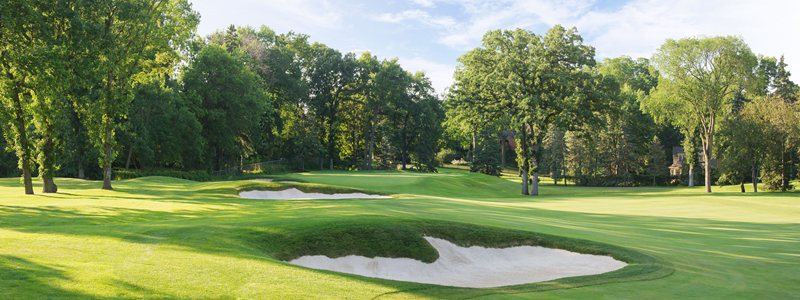 |
Hole 1
The first hole is a position hole. The bunker on the right side of the fairway is an ideal line for the tee shot. Avoid the left side because trees can block the second shot. It is possible for long hitters to go for the green in two shots, but the tee shot must be placed perfectly and there is considerable danger around the green. Beware of the pond directly right of the green and a cart path left of it that can make the OB more dangerous if a ball bounces off it. The green is large and breaks considerably toward the pond. If the hole is in the front, above it is very fast.
|
| Category |
Yards |
Men's Par |
Men's HCP |
Women's Par |
Women's HCP |
| Black |
531 |
5 |
3 |
5 |
3 |
| Tan |
526 |
5 |
3 |
5 |
3 |
| Blue |
500 |
5 |
3 |
5 |
3 |
| Yellow |
495 |
5 |
3 |
5 |
3 |
| Green |
450 |
5 |
3 |
5 |
3 |
|
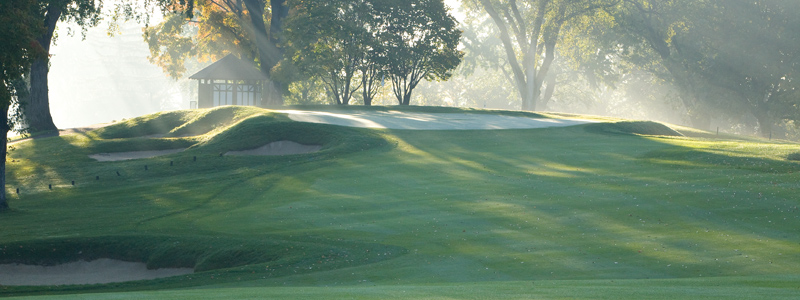 |
Hole 2
The par-4 second is a fun hole that can produce large numbers and ruin a round early despite its relatively short length. The ideal drive favors the right half because the fairway kicks left. Many players will use a fairway wood to stay short of the bunkers on both sides of the fairway. A defensive play to the middle of the green is highly recommended. Deep bunkers surrounding the long, narrow green are quintessential Donald Ross-style and frequently cause havoc for members, many of whom have horror stories of hitting bunker shots from one side of the green to the bunker on the other side or even blading a bunker shot down the hill on the left of the green to the eighth tee box. Putts above the hole are very fast and can end up off the front of the green. Patty Berg said, “If I could get past No. 2, I was in good shape.”
|
| Category |
Yards |
Men's Par |
Men's HCP |
Women's Par |
Women's HCP |
| Black |
396 |
4 |
13 |
4 |
9 |
| Tan |
338 |
4 |
13 |
4 |
9 |
| Blue |
324 |
4 |
13 |
4 |
9 |
| Yellow |
313 |
4 |
13 |
4 |
9 |
| Green |
267 |
4 |
13 |
4 |
9 |
|
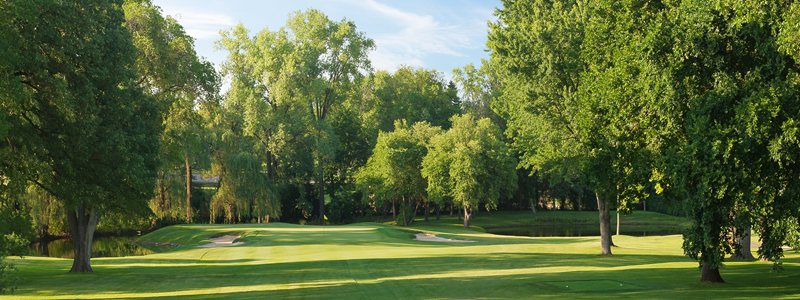 |
Hole 3
The third hole is a challenging par-3. The long green can make a two or three club difference. A pull hopefully will catch the greenside bunkers, but if not it will likely end up in the pond.
|
| Category |
Yards |
Men's Par |
Men's HCP |
Women's Par |
Women's HCP |
| Black |
226 |
3 |
9 |
3 |
17 |
| Tan |
172 |
3 |
9 |
3 |
17 |
| Blue |
162 |
3 |
9 |
3 |
17 |
| Yellow |
151 |
3 |
9 |
3 |
17 |
| Green |
115 |
3 |
9 |
3 |
17 |
|
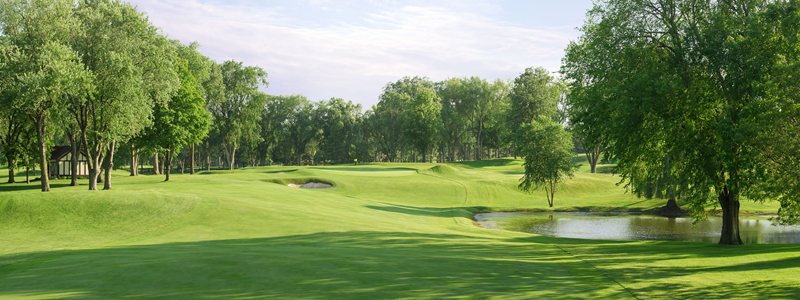 |
Hole 4
Long hitters can reach the par-5 fourth in two shots. But a new championship tee was added in 2006, adding 20 yards and making it tougher to get home in two. The slanted fairway kicks drives toward the left bunker. Drives too far right must contend with bunkers and trees that can block the second shot. A lay-up should favor the left side because the fairway slopes right toward a pond. The green is elevated, requiring an extra club. However, above the hole is very fast.
|
| Category |
Yards |
Men's Par |
Men's HCP |
Women's Par |
Women's HCP |
| Black |
575 |
5 |
5 |
5 |
1 |
| Tan |
519 |
5 |
5 |
5 |
1 |
| Blue |
479 |
5 |
5 |
5 |
1 |
| Yellow |
471 |
5 |
5 |
5 |
1 |
| Green |
418 |
5 |
5 |
5 |
1 |
|
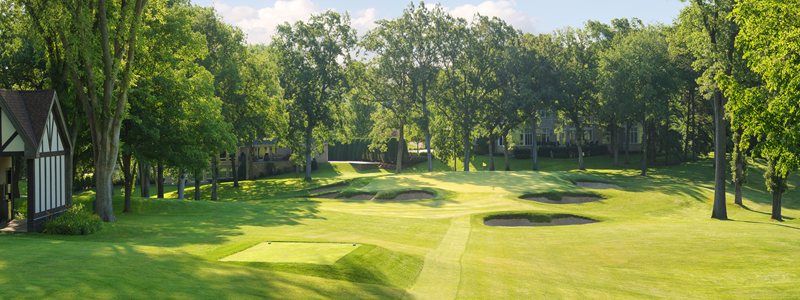 |
Hole 5
The par-3 fifth is one of Interlachen’s most straight-forward holes. The challenge is the green, which is large, but surrounded by bunkers. The green slopes considerably back to front so do not miss it long.
|
| Category |
Yards |
Men's Par |
Men's HCP |
Women's Par |
Women's HCP |
| Black |
186 |
3 |
17 |
3 |
15 |
| Tan |
162 |
3 |
17 |
3 |
15 |
| Blue |
138 |
3 |
17 |
3 |
15 |
| Yellow |
130 |
3 |
17 |
3 |
15 |
| Green |
94 |
3 |
17 |
3 |
15 |
|
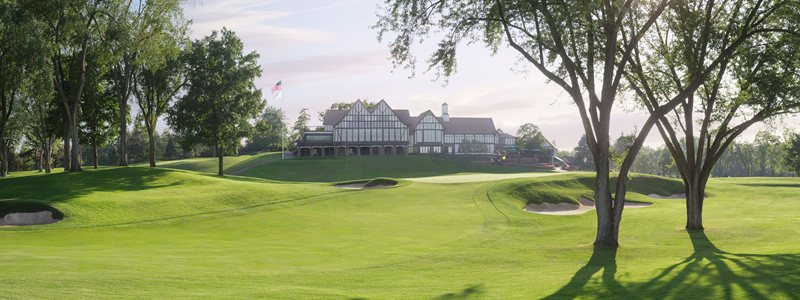 |
Hole 6
The sixth hole is a very good par-4. Many players hit a fairway wood or long iron to avoid bunkers on either side of the fairway. The uphill approach shot demands great precision and is one of the most nerve-wracking on the course (along with No. 2). Do not miss to the right because the greenside bunkers are arguably the toughest on the course. The first greenside bunker on the right has been known to members as “Big Mouth” since at least the 1950s. The bank in front of these bunkers is so steep that you probably will not be able to see the top of the flagstick.
|
| Category |
Yards |
Men's Par |
Men's HCP |
Women's Par |
Women's HCP |
| Black |
345 |
4 |
7 |
4 |
7 |
| Tan |
328 |
4 |
7 |
4 |
7 |
| Blue |
320 |
4 |
7 |
4 |
7 |
| Yellow |
313 |
4 |
7 |
4 |
7 |
| Green |
243 |
4 |
7 |
4 |
7 |
|
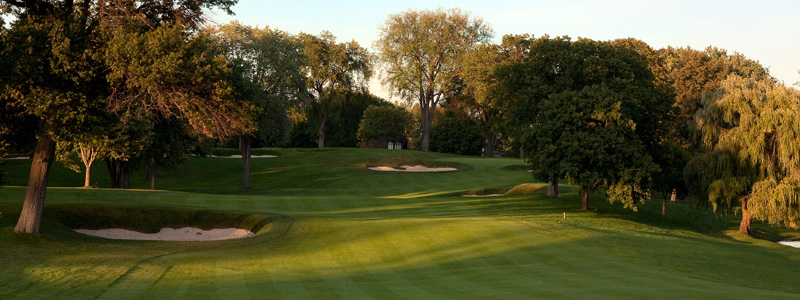 |
Hole 7
The seventh is another par-4 where position is important. It requires a well-placed tee shot on the left half of the fairway. Trees and water lurk on the right. A front hole location on the elevated green is very difficult because bunkers guarding it require flying the ball to the hole and stopping it quickly to avoid an extremely fast downhill putt.
|
| Category |
Yards |
Men's Par |
Men's HCP |
Women's Par |
Women's HCP |
| Black |
360 |
4 |
15 |
4 |
11 |
| Tan |
343 |
4 |
15 |
4 |
11 |
| Blue |
329 |
4 |
15 |
4 |
11 |
| Yellow |
317 |
4 |
15 |
4 |
11 |
| Green |
271 |
4 |
15 |
4 |
11 |
|
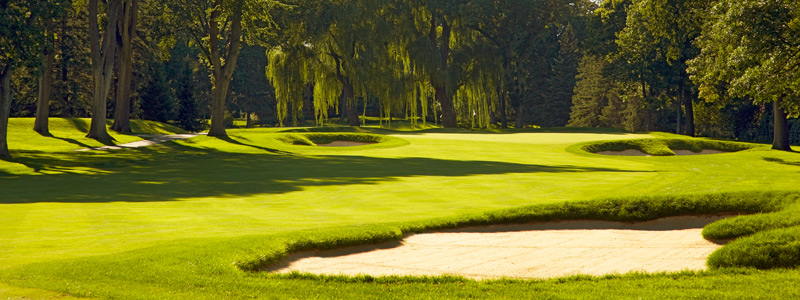 |
Hole 8
The eighth is one of Interlachen’s best par-4s. A new tee was added in 2006, which extended the hole nearly 40 yards. The ideal drive on this dogleg left favors the right side of the fairway. Also in 2006, a fairway bunker on the left was repositioned to jut into the fairway, making the tee shot all the more difficult. The green is slightly elevated, very difficult and fast if putting from above the hole.
|
| Category |
Yards |
Men's Par |
Men's HCP |
Women's Par |
Women's HCP |
| Black |
455 |
4 |
1 |
4 |
13 |
| Tan |
405 |
4 |
1 |
4 |
13 |
| Blue |
367 |
4 |
1 |
4 |
13 |
| Yellow |
301 |
4 |
1 |
4 |
13 |
| Green |
301 |
4 |
1 |
4 |
13 |
|
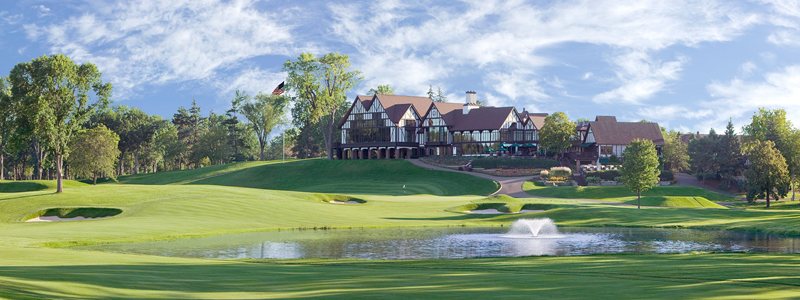 |
Hole 9
The ninth is Interlachen’s signature hole and site of Bobby Jones’ “lily pad” shot during the 1930 U.S. Open. It is a par-4 on which scores can range from eagle to several over par. The tee shot is challenging with bunkers on the left and trees on the right claiming many balls. Reaching the green in two shots is possible, given a well-placed drive on top of the hill short of the pond. The green is large and slopes back to front.
|
| Category |
Yards |
Men's Par |
Men's HCP |
Women's Par |
Women's HCP |
| Black |
530 |
5 |
11 |
5 |
5 |
| Tan |
518 |
5 |
11 |
5 |
5 |
| Blue |
491 |
5 |
11 |
5 |
5 |
| Yellow |
447 |
5 |
11 |
5 |
5 |
| Green |
447 |
5 |
11 |
5 |
5 |
|
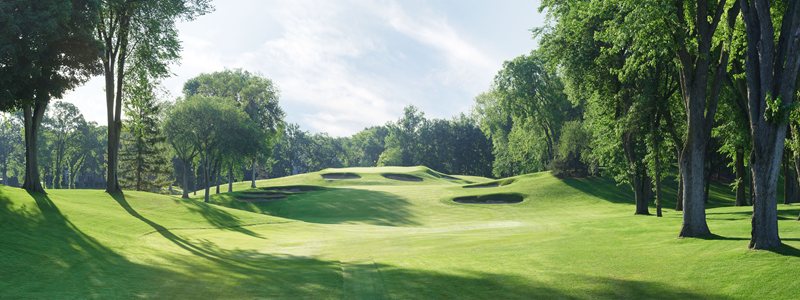 |
Hole 10
The par-4 tenth hole offers many challenges. Players can reach the flat area 100 yards short of the green with a driver. But being too close presents a challenging half-wedge shot and also brings the fairway bunkers into play on the tee shot. The elevated green, with treacherous bunkers surrounding it, requires an additional half-club. The large green is fast from behind the hole and breaks considerably toward the front if putting from the side.
|
| Category |
Yards |
Men's Par |
Men's HCP |
Women's Par |
Women's HCP |
| Black |
347 |
4 |
12 |
4 |
4 |
| Tan |
334 |
4 |
12 |
4 |
4 |
| Blue |
334 |
4 |
12 |
4 |
4 |
| Yellow |
328 |
4 |
12 |
4 |
4 |
| Green |
293 |
4 |
12 |
4 |
4 |
|
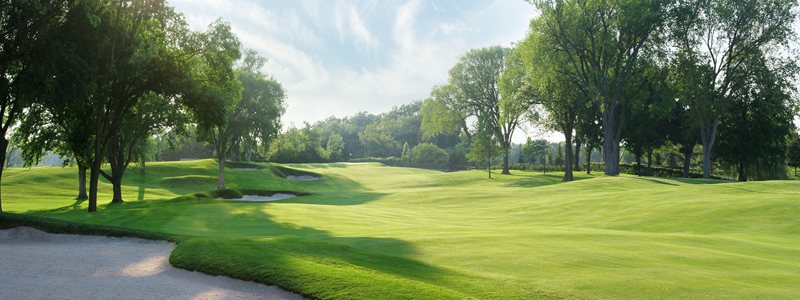 |
Hole 11
This demanding par 4 is a dogleg right that was converted from a par 5 in 2010. Players must first decide how much of the dogleg to cut off with their tee shot. An overly aggressive play could end up in deep trees or the pond on the right. Given a well-placed drive, the lengthy uphill approach shot requires precision with OB lurking closely on the right. A shot from behind the large green is one of the course's most challenging.
|
| Category |
Yards |
Men's Par |
Men's HCP |
Women's Par |
Women's HCP |
| Black |
458 |
4 |
4 |
5 |
8 |
| Tan |
420 |
4 |
4 |
5 |
8 |
| Blue |
402 |
4 |
4 |
5 |
8 |
| Yellow |
434 |
4 |
4 |
5 |
8 |
| Green |
402 |
4 |
4 |
5 |
8 |
|
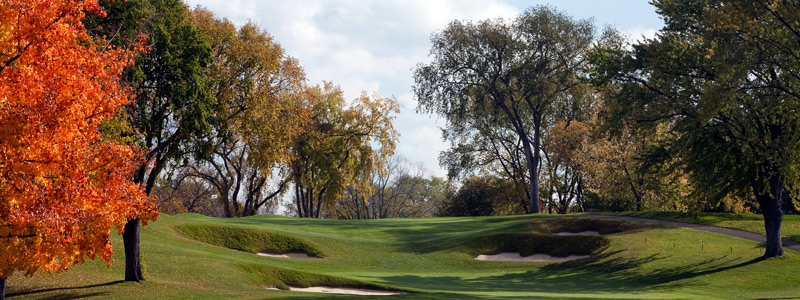 |
Hole 12
The par-5 12th Hole is a gentle dogleg left. However, there is nothing gentle about this tee shot. The landing area is guarded on the right by a penalty area. The bunker at the elbow provides a good aiming point from the tee. A thoughtful layup for most will set up a demanding approach shot to a well bunkered green. The green is severely sloped from back to front with a false front. Fittingly this hole is recognized often as one of the top 100 holes in America.
|
| Category |
Yards |
Men's Par |
Men's HCP |
Women's Par |
Women's HCP |
| Black |
557 |
5 |
2 |
5 |
2 |
| Tan |
541 |
5 |
2 |
5 |
2 |
| Blue |
501 |
5 |
2 |
5 |
2 |
| Yellow |
441 |
5 |
2 |
5 |
2 |
| Green |
441 |
5 |
2 |
5 |
2 |
|
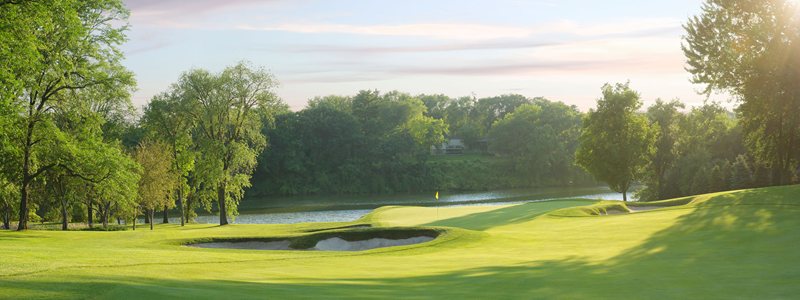 |
Hole 13
Mirror Lake is the picturesque backdrop to the downhill, par-3 13th hole. The green is large and difficult, breaking significantly to the left. Bunkers guard the front, right and left sides of the green. The only bailout is short and right, from where the ball can funnel onto the green. An aggressive shot to a back hole location could go over the green, which leaves a very difficult shot to a tight pin.
Forty-five years later, Tom Hoak recalled playing Len Bjorkland in the final of the 1961 club championship. “It was a foregone conclusion that I had won as I was 3 up going into 13.” Hoak said. “Len hit into the bunker. I was on the green, 25 feet from the cup. Len skulled it, hit the bank, ran it up into the hole for a 2. I never recovered and went on to lose the championship.”
|
| Category |
Yards |
Men's Par |
Men's HCP |
Women's Par |
Women's HCP |
| Black |
190 |
3 |
14 |
3 |
14 |
| Tan |
179 |
3 |
14 |
3 |
14 |
| Blue |
165 |
3 |
14 |
3 |
14 |
| Yellow |
162 |
3 |
14 |
3 |
14 |
| Green |
120 |
3 |
14 |
3 |
14 |
|
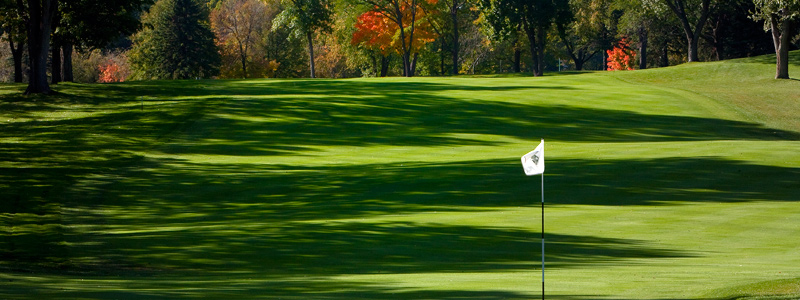 |
Hole 14
Let your driver go on the par-4 14th hole, which plays as a par-5 for women. But favor the left side because trees on the right can block shots to the green. This approach shot is challenging and one of the longest on the course. Bunkers left and right guard the green, while OB also lurks on the right.
|
| Category |
Yards |
Men's Par |
Men's HCP |
Women's Par |
Women's HCP |
| Black |
440 |
4 |
6 |
4 |
16 |
| Tan |
423 |
4 |
6 |
4 |
16 |
| Blue |
346 |
4 |
6 |
4 |
16 |
| Yellow |
416 |
4 |
6 |
4 |
16 |
| Green |
346 |
4 |
6 |
4 |
16 |
|
 |
Hole 15
The par-4 15th is a favorite of the members, which also plays as a par-5 for women. An aggressive shot with a driver or fairway wood needs to fade around the soft dogleg right, otherwise it could end up on the left side, blocked by trees with no shot to the green. If too much of the corner is cut, however, the ball could end up in the pond, bunker or deep trees on the right. The green is nestled slightly downhill. Do not miss behind the hole because the green slopes dramatically back to front.
|
| Category |
Yards |
Men's Par |
Men's HCP |
Women's Par |
Women's HCP |
| Black |
414 |
4 |
10 |
4 |
18 |
| Tan |
406 |
4 |
10 |
4 |
18 |
| Blue |
342 |
4 |
10 |
4 |
18 |
| Yellow |
390 |
4 |
10 |
4 |
18 |
| Green |
301 |
4 |
10 |
4 |
18 |
|
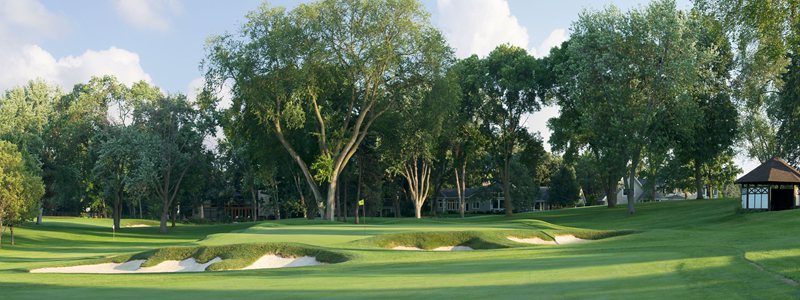 |
Hole 16
The 16th hole a short par-4 where placement of the drive is important. The ideal drive is a draw around the dogleg left with a long iron or fairway wood. A careless pull can catch the trees or a push can end up in bunkers. A short iron into the well-bunkered green will yield many birdies.
|
| Category |
Yards |
Men's Par |
Men's HCP |
Women's Par |
Women's HCP |
| Black |
318 |
4 |
18 |
4 |
10 |
| Tan |
311 |
4 |
18 |
4 |
10 |
| Blue |
311 |
4 |
18 |
4 |
10 |
| Yellow |
249 |
4 |
18 |
4 |
10 |
| Green |
249 |
4 |
18 |
4 |
10 |
|
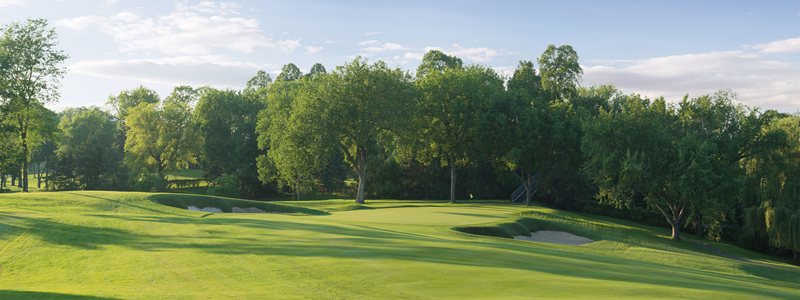 |
Hole 17
The 17th hole is Interlachen's longest par-3. Since shots will kick right toward the bunkers, the base of a thick tree directly behind and slightly left of the green's center is a great target. The green has a gentle break toward the pond on the right and putting toward it is faster than appears. This hole played at 262 yards in the 1930 U.S. Open and remained the longest par-3 in Open history until Oakmont in 2007. It is also the longest par-3 in U.S. Women’s Open history, playing to 234 yards during the final round in 2008.
|
| Category |
Yards |
Men's Par |
Men's HCP |
Women's Par |
Women's HCP |
| Black |
225 |
3 |
16 |
3 |
12 |
| Tan |
205 |
3 |
16 |
3 |
12 |
| Blue |
195 |
3 |
16 |
3 |
12 |
| Yellow |
187 |
3 |
16 |
3 |
12 |
| Green |
133 |
3 |
16 |
3 |
12 |
|
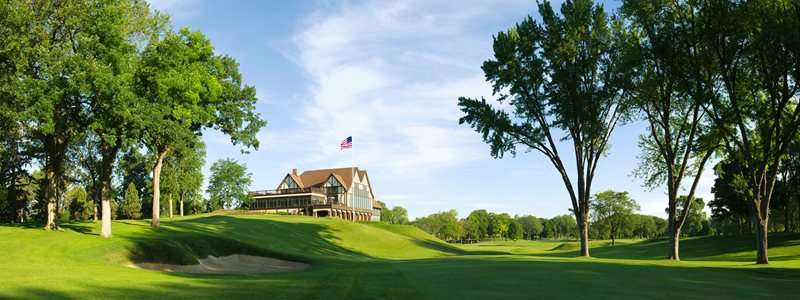 |
Hole 18
No. 18 is a challenging finishing hole. The difficult 17th and 18th holes are known to ruin otherwise good rounds. The drive on this par-4 is no bargain, requiring a fade to avoid hitting it through the fairway into trees and deep rough on the left. However, it is the approach shot into one of the toughest greens on the course that makes par a great score here. The approach, which requires an extra club, needs to get past the front third of the elevated green to avoid rolling off the front. However, just a foot or more over the green leaves one of the course's toughest shots, which usually needs to hit into the rough to slow the ball enough to trickle onto the green rather than fall off the front.
|
| Category |
Yards |
Men's Par |
Men's HCP |
Women's Par |
Women's HCP |
| Black |
428 |
4 |
8 |
4 |
6 |
| Tan |
385 |
4 |
8 |
4 |
6 |
| Blue |
369 |
4 |
8 |
4 |
6 |
| Yellow |
320 |
4 |
8 |
4 |
6 |
| Green |
296 |
4 |
8 |
4 |
6 |
|
|